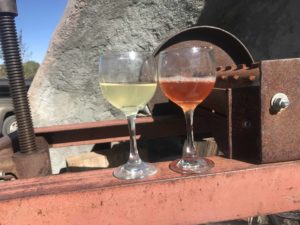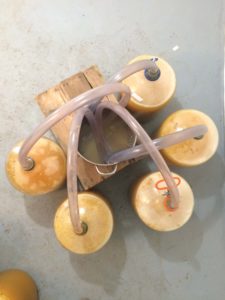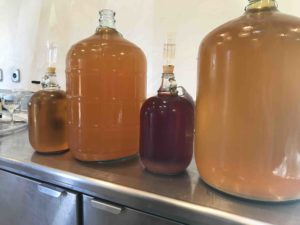Making Cider the Stoic Way
by Guest blogger: Kanin Routson
of Stoic Cider
Listen to his podcast HERE
In the Fall of 2006 the Flagstaff neighborhoods were overflowing with a bountiful apple crop. My brother Cody* and I were in college and decided to give cider-making a try for the first time. Filling a pickup truck with fruit, we employed a homemade apple press and our roommates to carry out the operation. Delicious, fresh-pressed golden cider flowed into 5-gallon glass carboys for fermentation, and that’s were our knowledge, attention, and success parted ways. With classwork and exams piling up, the cider was left forgotten in the basement. That first batch fermented to absolute dryness on its own spontaneous fermentation. Yeasty and a little sour with a hint of sulfur, not bad considering.
It turns out that vinegar, brettanomyces, and lactic acid bacteria can all contribute to undesirable flavors in cider. Characteristics of dirty mouse cage, band aides, barnyard, wet dog, and horse are often used to describe the flavors of these cider infections.
Fermenting fresh-pressed apple juice into hard apple cider is straight-forward and involves selecting fruit, pressing juice, adding yeast, fermenting, racking, maturing, and bottling. Over the last decade, we have compiled a few thoughts for making great cider and minimizing the chance of problems.
*Cody and Kanin are co-founders of Stoic Cider in Prescott, Arizona
The Stoic method for making hard cider
- Select clean, sound, ripe fruit with no rot. Apples with high flavor and unusual character generally ferment into better tasting cider. Once all of the sugar in a common grocery store apple is fermented out, often little flavor remains in the finished cider. Heritage fruit tend to have more flavor than many commercial varieties. Likewise, adding 10% crabapple juice to the fermentation can add an abundance of tannin, acidity, and flavor.
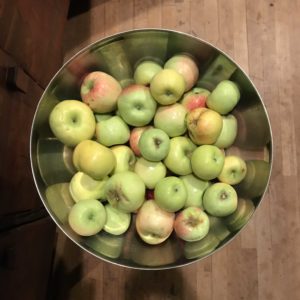
Farm-grown heritage apples.
- Press the fruit. Numerous pressing systems have been utilized over the years to juice apples. We utilize a wine press and a homemade rack and cloth press, though a home juicer can also be used successfully. A home juicer will yield a sediment-rich juice that may be allowed to settle for a couple of days. After the sediment has settled, the clear juice can be racked (transferred) into a new vessel for fermentation. Optional additions such as pectic enzyme to clarify the juice or 20-30 ppm sulfite to reduce oxidation have the potential to improve cider quality.

Fresh unfermented juice from two different crabapple varieties: Columbia crab apple juice on the left and Dolgo crab apple juice on the right.
- Clean and sanitize all equipment that comes into contact with the juice. This is highly important and reduces chances of the cider spoiling. We use an acid-based sanitizer.
- Ferment in a cool, dark location. A temperature of 50-60 degrees is ideal for preserving delicate fruity aroma and flavor in cider. (Warmer temperatures can result in a loss of fruity character and can promote spoilage organisms.)
- White wine yeast strains make great cider. Beer or mead yeast will also work, but many require warmer fermentation temperatures that can lead to increased chances of other problems. (Spontaneous fermentations can yield interesting and complex ciders, but often result in off-flavors and unpredictable results.)
- Minimize oxygen exposure. Early in a fermentation oxygen is good for the yeast, but spoilage-causing bacteria thrive with exposure to oxygen and oxidation can also occur. Use an airlock to ensure that oxygen and bacteria are prevented from coming in contact with the cider.

Five-gallon glass carboys of cider undergoing fermentation with the water bucket as an airlock.
- Rack the cider off the lees at the end of primary fermentation. Aging cider on the lees can add a full-bodied flavor, but lees that are too thick can rot at the bottom of the fermentation vessel producing very disagreeable flavors.
- Mature cider in a cool, dark location and prevent contact with oxygen. Maturation can take one to six months to complete. When the cider has clarified and the lees have settled, it is a good indication the cider is ready for drinking.

Small batch cider fermentations maturing in one- and seven-gallon glass carboys.
- Optional carbonation. Carbonation adds tiny bubbles to the cider for additional texture and mouth feel. “Forced carbonation” is a common method of bubbling CO2 through the cider in a pressurized tank. “Methode champenoise” is a traditional method of using a small amount of sugar and yeast to carbonate the cider during bottling. Results are harder to predict with this method, though it is simpler and requires less set-up. Cider can also be enjoyed still.
- Enjoy! Cold cider on a warm evening is a delicious and refreshing beverage. Enjoy with friends on its own or with cheese, bread, or a meal.
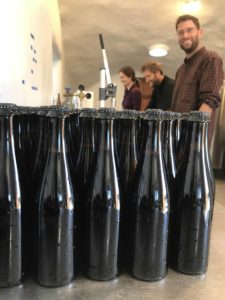
Bottling Day at Stoic Cider- from left: Tierney Routson, Kanin Routson, Cody Routson
www.urbanfarm.org/makingstoiccider
About this author:
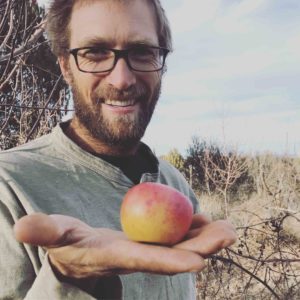 Kanin has devoted his life, including two graduate degrees, to exploring and promoting apple tree diversity. His latest work has been co-founding Stoic Cider, a local hard cider company based out of Prescott, Arizona. Through the RAD Project (Restoring Apple Diversity), Stoic Cider works to find, propagate, and promote unique apple varieties and to celebrate this diversity through hard apple cider.
Kanin has devoted his life, including two graduate degrees, to exploring and promoting apple tree diversity. His latest work has been co-founding Stoic Cider, a local hard cider company based out of Prescott, Arizona. Through the RAD Project (Restoring Apple Diversity), Stoic Cider works to find, propagate, and promote unique apple varieties and to celebrate this diversity through hard apple cider.
Stoic Cider is growing and preserving local heritage apples, wild apples, and European and American cider varieties in several orchards on the family farm. They utilize white wine making techniques to create premium, dry, fruit-forward ciders.
How to reach Kanin:
Website – StoicCider.com
Email – cider@stoiccider.com
Instagram – Stoic Cider
Stoic Cider can be found in most Whole Foods Markets across Arizona


